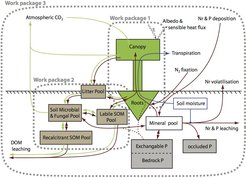Quantifying the effects of interacting nutrient cycles on terrestrial biosphere dynamics and their climate feedbacks (QUINCY)
lifetime: September 2015 - August 2020
Nutrient availability plays a pivotal role in the response of terrestrial ecosystems to increasing atmospheric CO2 and climate change. The first generation of global nutrient-carbon cycle models shows strongly diverging estimates of the nutrient effect, resulting from lacking integration of ecosystem observations and fundamental uncertainties in the representation of governing processes. The objective of QUINCY is to clarify the role of the interacting terrestrial nitrogen and phosphorus cycles and their effects on terrestrial C allocation and residence times as well as terrestrial water fluxes.


QUINCY will create a novel, predictive framework founded on the principle of resource optimisation, shifting the paradigm of terrestrial biosphere modelling towards an active biological control of matter flows. QUINCY’s main themes are
- the effects of nutrient availability on plant photosynthesis and respiration by explicitly taking the energy requirement of nutrient acquisition into account, and
- the effects of vegetation-soil interactions, namely rhizosphere processes, on plant nutrient availability and soil C turnover.
To corroborate these theoretical concepts, QUINCY will synthesise existing and ongoing ecosystem monitoring and manipulation studies. To specifically test emerging hypotheses on the effects of rhizosphere priming on soil C storage and plant nutrition - and to provide currently lacking data for soil-vegetation models - QUINCY will establish a tree mesocosm, elevated CO2 experiment. The novel model concepts will be consistently integrated to form a new general terrestrial biosphere model to address the multiway interactions of carbon, nitrogen, phosphorus and water cycles globally in a theoretically well-founded way commensurate with ecosystem observations. This novel model will be based on earlier works of TBM with the OCN terrestrial biosphere model, and will be integrated as new/alternative land surface scheme of the MPI Earth system model.
Conceptual diagram of the major pools and fluxes of carbon (C), nitrogen (N) and phosphorus (P) in terrestrial ecosystems. C fluxes are displayed in green, nutrient (N and/or P) fluxes in brown, recognising that the stoichiometry of these fluxes is time-variant, different for each flux, and dependent on the state of the ecosystem. DOM: dissolved organic matter; Nr: reactive nitrogen species, e.g. NH4 and NO3; SOM: soil organic matter.

Research within QUNICY is organised into two process-oriented work packages (work package 1: Novel paradigms for nutrient availability effects on plant growth nutrient limitation in plants; work package 2: Interactions of rhizosphere processes and nutrient availability), displayed as grey dashed areas, which will be integrated by the third overarching work package (work package 3: Frontier Applications in global terrestrial biogeochemistry).


